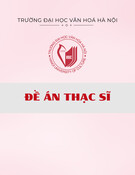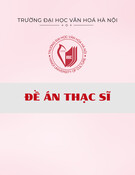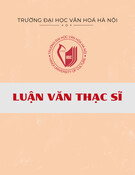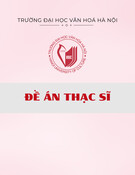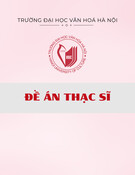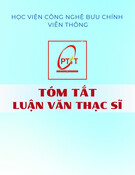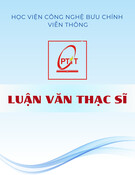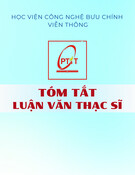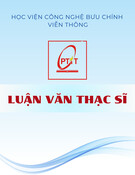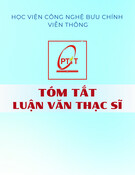1 PART 1 INTRODUCTION
1. Background
Dong Hy is a mountainous district of Thai Nguyen Province with total natural area of 46,177 ha in which there are 26% of agricultural land, 45% of forest land, 0.37% of aquaculture, 5% of land for specific purposes; 2% of living land; 22% of unused land. The structure of agricultural land includes 53% for annual crops, 39% for perennial crops, and 8% for others. The annual crops include cereal crop group, short-term industrial plant group, group of vegetables and beans. The perennial crops include tea, litchi, longan, mango, jackfruit plants etc.
With the land, crop structure as well as the natural - economic and social conditions of Dong Hy District as mentioned above; to gradually change the cropping system forward to market oriented production and to develop the sustainable agriculture system definitely needs research on improving cropping systems in Dong Hy District. Based on these issues, we conducted a study titled “Study on improving the cropping systems on some main soil types in Dong Hy District - Thai Nguyen Province.” 2. Research objectives
- Researching for improved cropping systems with proposed cropping structure on rice-based land in Dong Hy District, Thai Nguyen Province in the period of 2010 -2020.
- Researching and applying some cultivation techniques for the tea production on hilly land in Dong Hy District, Thai Nguyen Province. 3. Research requirements - Evaluating the current cropping systems on rice-based and hilly land in Dong Hy District.
- Studying to select the suitable varieties of crops in the spring, summer and winter crops on rice-based land. Studying on some suitable techniques for tea production on hilly land. - Building demonstration plots on rice-based and hilly land based on research results obtained. - Proposing development plans for new cropping systems in Dong Hy District in the future.
2
4. Research limit
The study focuses on analyzing and evaluating the status of crop production on some main kinds of agriculture land in Dong Hy District, including cropping systems on one-rice crop land, two-cropland and three-crop land of rice-based land system; perennial cropping systems on hilly land in Dong Hy District;
The study focuses on testing for selection of some new varieties with high yield - high economic efficiency and building demonstration plots on rice-based lowland in Dong Hy District, testing for selection of chemical fertilizer rates combined with microbial fertilizer for tea on hilly land, testing some techniques for moisture maintenance in tea field in winter season and building demonstration plots for sustainable tea production – high economic efficiency from tea production in Dong Hy District. 5. New findings of the study
- For annual crops on rice-based lowland in Dong Hy District: Improved crop varieties in this area have increased the productivity and economic efficiency of the rotation treatment.
- Additional winter potato crop on two-rice lowland has increased the economic efficiency of crop rotation treatment and improved soil nutrient content.
- Additional peanut crop or soybean crop on one-rice lowland has increased the productivity and economic efficiency of cropping systems and soil nutrient properties.
- Studying and building the demonstration model of sustainable tea production with some technical methods such as balanced-fertilizer combined, moisture maintenance in winter-spring crops increased not only productivity - economic efficiency but also soil nutrient properties.
PART 2 LITERATURE REVIEW AND SCIENCETIFIC BASIS
2.1. Scientific basis of cropping systems 2.1.1. Concepts
* Cropping systems A cropping system is a composition of breeds and varieties that are arranged in areas and time in all kinds of agricultural ecosystems to make the best of natural - economic and social conditions (Dao The Tuan, 1984). A cropping system is an arrangement of all plants in an
3 interaction-relationship that is suitably arranged in areas and time (Nguyen Duy Tinh, 1995).
includes
*Improved cropping systems According to Pham Chi Thanh et al. (1996), an improved cropping system local cropping system and advanced techniques. This is the way of inheriting the good that was accumulated by local people; therefore researching and developing the cropping system must evaluate the current cropping system. The word “current” means the techniques that have been accepted by local people. Advanced techniques are the new ones that have never appeared in locate and increased production efficiency.
* Logical cropping systems A logical cropping system is stabilization in aspect of organizing crops on farmland in quantities, ratio, species, locations and time to create a synergy of organic interaction relationships among all kinds of crops to exploit and use economically and reasonably natural resources for economic-social development purposes (Khai Tran, 1994).
The logical cropping system is the system suitable with natural and economic - social conditions of province (Dao The Tuan, 1989), (Phung Dang Chinh et al, 1987). The logical cropping system also show the effectiveness of the relationship between plants located on the field - make the cultivation production develop comprehensively, strongly and firmly towards intensive cultivation associated with multi- cultivation, production of goods and high economic efficiency. The logical cropping system is a reality objective that is formed from specific natural and socio-economic conditions and motivates over time. 2.2. Overview of cropping system research 2.2.1. Cropping system research in the world
According to Flach et al (1989), the crop rotation is sequences of plant arrangements on the same part of land in each seasonal crop of each type of crop. The crop rotation is used importantly in maintaining the fertility of soil; preventing the increase of diseases, pests, weeds; and controlling and limiting erosion.
Since 1980 in the Southern region in China, there has studied for the ecological agriculture. Xiaoliang is a hilly area of Guangdong that had vigorous desertification, erosion and high ground temperature. It is used to be planted eucalyptus, but were unsuccessful. Finally, local
4 people selected cropping systems with crop diversification and multi- layer plants. There were protected forest trees at the top of the hill, orchard plants in the middle and crops grown in the valley.
Rubber trees at hills were planted in rows of 10-15 meters long and 2.5 meters wide combined with one row of tea plants intercropped. According to Trieu Quoc Ky (1994) on two-rice cropland in Southern mountainous region used to be planted two to three seasonal crops with cropping systems of rice-wheat-potato or peanut-soybean-wheat. On one-rice crop-land of plateau (Van Nam, Quy Chau, Tu Xuyen and Tay Tang provinces), cropping systems were rice in rotation with upland crops. 2.2.2. The cropping system research in Vietnam
Bui Huy Dap (1977, 1987, 1994), on his overview of research in Northern mountainous region, indicated that the proper cultivations in some type of agricultural land in mountainous areas are cropping systems of spring rice-summer rice on lowland in the valley and terrace fields in low mountainous areas; cropping systems of summer rice- potato (or green bean- green manure plants) in areas where there is no water in the winter-spring crops.
On the land with history of planting one-crop of spring maize or spring-summer maize, we can added peas, white beans as winter crops. The research on applying technical methods to improve the efficiency of one-crop-lowland in Northern mountainous region (Le Quoc Doanh et al, 2007) showed that by variety selection and land mulching we can increase the seasonal crops with 2 treatment: spring soybean-short term summer rice resulting in the profits from 16.8 to one-rice crop with 8.0 million VND/ha/year compared million/ha/year. Treatment of spring peanut- short-term summer rice gave the profit of 21.2 million VND/ha/year higher than the control of one-rice crop by 9.6 millions VND/ha/year. PART 3 REASERCH CONTENTS AND METHODOLOGY
3.1. Research Contents 3.1. Assessing the impact of natural, economic - social conditions in Dong Hy District on cropping systems 3.2. Assessing the current cropping systems in Dong Hy District 3.3. Study on improving cropping systems in a main kind of land in Dong Hy District
5
3.3. Research Methodology 3.3.1. Collecting secondary data
Sources of data extracted from related organizations in research areas. 3.3.2. Direct investigation Using the questions in the questionnaires to collect data by
region, subjects in the study area. 3.3.3. Experiments for selecting crop varieties on rice-based lowland and some technical methods for tea cultivation in Dong Hy District The experiments were designed according to the method of
field experiments and were conducted on farmer fields in study sites. 3.3.4. Building demonstration plots The plots on two-rice cropland, one-rice cropland and for
sustainable tea production on hilly land. 3.3.5. Analyzing nutrient elements of soil in the model areas
Taking soil samples before and after implementing models (taken from the cultivation soil layer from 0 to 30 cm of hilly land; layer from 0 to 20 cm for rice-based lowland), 3.3.6. Analyzing experimental data: Field experiments’ data were analyzed by analysis of variance, regression analysis using SAS and IRRSAT software.
PART 4 RESULTS AND DISCUSSION 4.1. Results from assessing impacts of natural, economic - social conditions on cropping systems in Dong Hy District, Thai Nguyen Province 4.1.1. Topography and land
According to statistic data, a total area of land used for cultivation was 46.117,2 ha and is divided into five main groups. The survey results on current use of these types of land were shown in Table 4.1.
Table 4.1: The main soil types in Dong Hy District
Current use Soil Groups Area (ha)
127.8 Vegetables
1657.3 Rice - Vegetables 1. Alluvial soil with less deposition 2. Alluvial soil with no deposition
Rice
3. Eluvial soil at valley 4. Acrisols 5. Alisols Total
6 8,188.3 22,357.4 Forest, tea plants, fruit trees 13,846.4 Forest, tea plants, fruit trees 46,117.2 Source: Statistic Department, Dong Hy District, 2005
4.1.2. Economic - social characteristics
- Population: Dong Hy District has an average population level compared to other districts of Thai Nguyen Province. According to statistic data in 2005, Dong Hy district's population was 124,196 people; the population density was 270 people/km2. The people mainly lived in rural areas (more than 86%); the others lived in urban areas (14%).
- The infrastructure was in average level. Traffic was quite convenient; the national electricity has nearly reached to all the communes of the District.
Irrigation: there are Cau River, Linh Nham stream and Dac waterfall in the District, with a total length is 94 km. This is the main water source for production. 4.2. Results from monitoring some characteristics of the cropping system in Dong Hy District 4.2.1. Assessing characteristics of cropping systems on rice-based lowland 4.2.1.1. Annual crops’ structure and area
Annual crops’ structure and area of Dong Hy in years 2000 - 2005 showed that there was four major crop groups, including Food grain crops; starch root plants; annual industrial crops and all kinds of vegetables, beans. Table 4.2: Annual crops’ structure and area
Crops Total area
I. Food grains 1. Rice - Winter spring - Summer 2. Maize 2001 10.841 7,856 6,484 2,125 4,359 1,372 2002 11.939 8,478 6,568 2,210 4,358 1,910 2003 11.789 8,761 6,677 2,319 4,358 2,084 Unit: ha 2005 11.605 8,984 6,667 2,341 4,326 2,318 2004 11.658 8,963 6,657 2,304 4,353 2,306
7
2002 1,329 938 369 22 1,093 679 414 2001 1,113 756 340 17 907 513 394 2003 991 729 248 14 1,199 739 460 2004 894 639 252 3 1,047 815 232 2005 782 543 229 10 1,215 959 256
1,057 965 838 754 625
Crops II. Root crops for starch 1. Sweet potato 2. Cassava 3. Others III. Vegetables, beans 1. Vegetables 2. Beans IV. Annual industrial plants 1. Soybeans 2. Peanuts 3. Sesames 4. Sugarcanes 528 501 6 22 402 517 12 34 410 418 2 8 333 410 1 9 265 331 20 9
(Statistics Department, Thai Nguyen 2005) 4.2.1.2. Economic efficiency of crop rotation systems on rice-based lowland.
Rotational treatment n Crop yields in some rotational treatments were shown in Table 4.3 Table 4.3: Crop yields on the land with tree crops per year Yield x ± Sx. (tons/ha) Crop 2 Crop 1 Crop 3
1. Spring peanut– Rice – corn 2. Soybean – Rice – corn 3. Sweet potato – Rice – corn 32 1.03 ± 0.26 4.53 ± 0.32 3.49 ± 0.53 30 1.14 ± 0.15 4.39 ± 0.35 3.24 ± 0.47 28 3.99 ± 0.48 4.02 ± 0.38 3.13 ± 0.39
(Source: 2005 survey data)
The table 4.10 showed that: the yield of winter corn in the land with three crops were from 3.13 – 3.49 tons/ha; the yields of summer rice were from 4.02 – 4.53 tons/ha.
8 Table 4.4: Economic efficiency comparison among the rotation formulas on 3-crop lowland in Dong Hy District Investment
Total Interest Rotational Treatment cost Incomes
Million VND /ha
1. Spring peanut– Rice – corn 39.38 13.12 26.26
2. Soybean – Rice – corn 41.92 13.95 27.97
3. Sweet potato – Rice – corn 36.59 11.19 25.40
(The average price in 2005)
Economic efficiency of the rotational Treatments showed that the treatments of Soybean – Rice – corn and Spring peanut– Rice – corn gave higher incomes than the treatment of Sweet potato – Rice – corn and gained the interest from 26.26 – 27.97 million VND/ha/year. These treatment also were chosen for continuous study. Table 4.5: Rice yields on the 2-crop lowland in some topography
Topography Area (ha) n
Rice yield x ± Sx (tons/ha) Spring crop Summer crop 4.37 ± 1.08 4.82 ± 0.52 4.63 ± 0.61 4.24 ± 0.59 4.53 ± 0.61 4.05 ± 0.82 320 600 245 1. High 2. Average 3. Low
29 38 25 (Survey data 2005) Table 4.6: economic efficiency Comparison of 2-rice crop treatment in some land topography in Dong Hy District
Interest Topography Total incomes
1. High 2. Average 3. Low 34.44 37.40 34.72 Investment cost Million VND /ha 12.48 11. 58 12.00 21.96 25.82 22.72
(The average price in 2005)
9
About the economic efficiency on 2-rice crop lowland, the incomes were from 21.96 to 25.82 million VND / ha / year. The average land topography with 2-rice crops had the highest income. 4.2.1.3. Effects of land use systems to soil fertility
Survey data collected on five indicators of soil in three different land use systems in Dong Hy District showed that pHKCL of soil ranged from 4.2 to 6.7, increasing gradually from the first crop to third crop; the content of organic matter in surface soil increased from 0.92% - 2.97%. Table 4.7: Some indicators of soil on fields with 3-crop cultivated per year N K2O Sample No. OC % pH KCL
1 2 3 Average 6.2 7.3 6.6 6.7 4.25 3.48 4.31 4.01 P2O5 mg/100g dry soil 22.20 18.52 16.72 19.14 10.66 7.39. 3.57 7.20 2.41 3.25 3.26 2.97 Table 4.8: Some indicators of soil from 2-rice crop lowland N K2O Sample No. OC %
1 2 3 Average pH KCL 5.1 4.9 5.3 5.1 P2O5 mg/10) g dry soil 6.89 8.52 6.18 7.19 21.20 10.03 4.23 11.82 8.12 6.78 6.73 7.21 1.10 2.01 1.12 1.61
Table 4.9: Some indicators of soil from one- rice crop lowland
N K2O Sample No. OC % pH KCL
1 2 3 Average 3.7 4.8 4.0 4.2 P2O5 mg/100 g dry soil 1.81 9.68 0.58 4.02 5.39 3.50 7.21 5.36 3.20 4.73 1.79 3.24 0.89 0.98 0.90 0.92
4.2.1.4. Evaluating the cropping system characteristics on rice-based lowland of the study site using farmer participatory method
The results of farmers’ opinions in 1-rice crop lowland showed that: some plants that always used were rice in summer crops; corn,
10 beans, sweet potatoes in spring crops; cassava and sesame in periods of long-term drought. Table 4.10: Survey results on some crop characteristics on one-rice crop lowland
Unit: percentage / questionnaires
Economic efficiency (%)
Adaptability to land, weather (%)
Crops
Resistance ability to pest – diseases and unfavorableness
High Average Low High Average Low High Average Low 23.3 36.7 60.0 16.7 46.7 56.7 6.6 30.0 73.4
40.0 26.7 63.4
26.7 20.0 23.3
13.3 23.3 3.3
50.0 33.3 73.4
26.7 50.0 20.0
23.3 26.6 6.6
60.0
23.4
16.6
73.4
16.6
10.0
30.0
50.0
20.0
Rice Corn Beans Sweet potato Cassava
66.7
23.3
10.0
23.4
63.3
13.3
70.0 26.7 3.3 (Survey data, 2005)
In two-rice crop lowland, farmers said that some plants which were cultivated were rice plants (in spring and summer crops), corn plants (mainly in winter crops – currently has considered as an important plants in supplying feed for livestocks), peanuts and soybeans (mainly in spring crops),
Table 4.11: Assessment results of farmers on some plant characteristics on two-rice crop lowland Unit: percentage / questionnaires
Economic efficiency (%) Adaptability to land, weather (%) Crops Resistance ability to pest – diseases and unfavorableness
High Average Low High Average Low High 51.7 90.0 58.4 46.7 78.3 36.7 56.7 35.0 23.4 13.4 18.4 33.4 28.4 25.0 6.7 40.0 51.6 48.4 56.6 58.3 63.4 51.7 28.3 13.4 53.3 56.7 70.0 61.6 40.0 68.4 80.0 43.4 38.4 31.7 18.4 8.3 3.3 6.6 3.3 5.0 5.0 20.0 Average Low 18.3 5.0 3.3 13.3 18.3 11.6 5.0 30.0 36.6 18.4 30.0 58.3 70.0 66.6 Rice Corn Peanut Soybean Beans Sweet potato Vegetables
3.3 13.3 11.7 16.6 30.0 8.3 11.6 (Survey data, 2005)
11 4.2.2. Evaluating on agricultural cropping system characteristics on hilly land in Dong Hy District
Based on statistic data, Dong Hy District has a total natural area of about 46 thousands ha. The perennial crops were mainly tea and fruit plants. Table 4.12: Area and productivity of perennial crops in years of 2001 to 2005 in Dong Hy District
Year
2001 2002 2003 2004 2005 Tea plants Ratio (%) 42.85 45.03 50.28 51.46 53.66 Yield (tons/ha) 62.54 69.00 54.41 72.10 73.49 Area (ha) 2532.1 2532.1 2307.04 2252.04 2080.04 Fruit plants Ratio (%) 57.15 54.97 49.72 48.54 46.34 Yield (tons/ha) 11.74 12.55 9.84 13.70 15.60
Area (ha) 1899.0 2074.0 2382.8 2487.8 2589.8 (Source: Statistics Department, Thai Nguyen 2005)
From the changes in area and yield of tea trees and fruit trees on hilly land in Dong Hy, we conducted a survey on some characteristics of these crops. The obtained results were showed in Table 4.13.
Table 4.13: Survey results on crop characteristics on hilly land in Dong Hy district Unit: percentage / questionnaires
Economic efficiency (%)
Crops
Adaptability and farmer’s acceptable level (%)
Tea Litchi Longan Mango Jackfruit
Labour attractiveness ability (%) High Average Low High Average Low High Average Low 3.3 13.3 73.4 10.0 40.0 40.0 26.6 43.3 46.7 23.3 43.3 26.7 23.3 50.0 56.7
3.3 36.6 30.0 40.0 20.0
10.0 60.0 40.0 40.0 26.7
86.7 30.0 33.4 36.7 50.0
83.4 23.4 26.7 16.7 20.0
23.3 50.0 36.6 60.0 40.0
3.3 10.0 16.7 13.3 3.3 (Survey data, 2005)
4.3. Research results on improving the cropping systems 4.3.1. The trial study on plant variety selection on rice-based lowland 4.3.1.1. Results of rive variety selection on two-rice crop lowland
12
The rice varieties was being tested continuously in the fields of farmers in three spring crops (2004, 2005, and 2006). The yield results were shown in Table 4.14. Table 4.14: Yield of some studied rice varieties in spring crops years 2004, 2005, 2006 Yields (tons/ha) Varieties 2004 2005 2006 Average
Khang dan HYT 83 HYT 100 LVN 20 HC1
Compared to control (%) 100 142.5 161.9 150.7 137.1 LSd05 CV% 4.86 6.80 7.77 7.29 6.60 0.44 2.0 4.53 6.62 7.53 7.12 6.50 0.40 1.9 4.91 6.93 7.82 7.11 6.48 0.63 2.9 4.76 6.78 7.70 7.17 6.52
Varieties
The Table showed that the varieties got highest yield was HYT100 (7.776 tons/ha); LVN20’s yield was 7.290 tons/ ha; varieties gaining average yield were HYT83 (6.804 tons/ ha), HC1 (6.609 tons/ ha). The control variety got the lowest yield (4.86 tons/ ha). The experiments conducted in three continuous cropping seasons in years 2004, 2005 and 2006 showed that all four varieties gave higher yields than the control (Khang dan) by 37.1% to 61.9%. * Variety selection in summer crop The experiment was continuously conducted in summer crops in years 2004, 2005 and 2006; the results showed that four studied varieties got higher yield than the control by 29.2 to 46.5%. In four varieties, there were two varieties that were selected were HYT100 and LVN20 - higher yield than the control by 37.8 to 46.5%. Table 4.15: Yield of some studied rice varieties in summer crops years 2004, 2005, 2006 Yields (tons/ha) 2005 4.62 6.43 Compared to control (%) 100 129.2 2006 Average 4.81 6.51 2004 5.53 6.37 4.98 6.43 Khang dan HYT 83
Varieties
HYT100 LVN20 HC1
2004 7.24 6.75 7.02 1.2 0.15
13 Yields (tons/ha) 2005 7.52 6.85 6.83 1.9 0.37
2006 Average 7.13 7.00 6.51 1.7 0.35 7.29 6.86 6.78 Compared to control (%) 146.5 137.8 136.2 CV% LSd0,05
4.3.1.2. Results of selecting corn varieties as the third crop on irrigated lowland
The experimental results in years 2004, 2005, and 2006 were shown in Table 4.16. Based on those results, the suitable corn varieties for winter crops on irrigated lowland in studied area were LVN 99 and SC164 that had higher yield than the control NVL4 by 30.8% to 43.6%. Table 4.16: Yields of corn varieties in winter crops in years 2004, 2005 and 2006 Yields (tons/ha) Varieties 2004 2005 2006 Average
LVN4 5.49 5.32 5.17 5.32 Compared to the control (%) 100
LVN10 5.89 5.74 5.68 5.77 108.4
LVN99 6.98 7.00 6.92 6.96 130.8
6.61 6.51 6.43 6.51 122.4 SC 184
7.93 7.52 7.47 7.64 143.6 SC 164
CV% 3.2 2.3 2.1
0.27 0.28 0.12 LSd0,05
4.3.1.3. Results of selecting potato varieties on two-rice crop land There were two varieties (Diamant and VC 888) that had higher yield than the control KT3 from 147.4 to 149.7%.
14 Table 4.17: Yields of potato varieties in winter crops in years 2004, 2005 and 2006
Yields (tons/ha) Varieties
2004 15.71 13.76 12.31 14.41 9.55 3.8 0.44 2005 13.76 12.70 12.02 14.07 10.01 2.7 1.08 2006 14.52 12.01 12.55 14.82 9.83 5.0 2.07 Average 14.66 12.82 12.29 14.43 9.79 Compared to the control (%) 149.7 130.9 125.5 147.4 100 Diamant So lara Maricula VC 888 KT 3 (ñ/c) CV% LSd05
4.3.1.4. Results of selecting peanut varieties on one-rice crop land
Varieties
2004 3.19 4.01 2.92 3.87 4.19 3.01 2.5 0.28 Table 4.18: Comparison results of some peanut varieties in years 2004, 2005 and 2006 Yields (tons/ha) 2005 3.02 4.05 3.04 3.93 4.23 3.15 2.9 0.33 2006 Average 3.26 3.68 3.13 3.51 4.30 3.20 2.0 0.22 Compared to the control (%) 101.1 125.4 97.1 120.8 135.8 100 3.15 3.91 3.03 3.77 4.24 3.12
1. MD 09 2. L08 3. L12 4. MD 07 5. L14 6. ðo BG (ñ/c) CV% LSd05 The results in 3 seasons for spring peanut on one-rice crop lowland showed that there were two varieties MD09 and L12 that had yield as high as the control Do BG did. There were 2 varieties L08 and L14 that had higher yield than the control by 25.4% to 35.8%. 4.3.1.5. Results of selecting some soybean varieties on one-crop land
Results comparing among 3 crops (2004, 2005 and 2006) showed that all studied varieties had higher yield than the control DT84 in which 3 varieties DT 96, Tu quy xanh and VX 92 had higher yield than the control by 41.9% to 102.1%.
Varieties
DT84 DT96 KT5 Tu quy xanh VX92
15 Table 4.19: Yields of some soybean varieties in year 2004, 2005 and 2006 Yields (tons/ha) 2005 1.43 3.01 2.14 2.24 2.23 2.6 0.19
2006 Average 1.57 3.13 2.05 2.00 2.38 2.9 0.20 Compared to the control (%) 100 202.1 138.4 141.9 145.1 2004 1.65 3.26 2.25 2.36 2.12 2.4 0.11 1.55 3.13 2.14 2.20 2.25 CV% LSd05
4.3.2. Study on applying fertilizers and some technical method of maintaining soil moisture for tea plants 4.3.2.1. Study on suitable fertilizer combinations for tea plants on hilly land in Dong Hy District Table 4.20: Effect of fertilizer doses on yield of tea plants in 2006
Yield of fresh tea of each harvest time (kg/plot)
Treatments
1
2
3
4
5
6
7
8
9
10
Yields of fresh tea (tons/ha)
1 (ñ/c) 2 3 4 5
5.37 6.27 6.30 6.37 5.70
5.73 6.57 7.13 7.00 6.47
5.80 7.17 7.43 7.10 6.77
6.23 7.23 7.27 7.17 6.57
6.07 7.13 7.60 7.50 6.93
5.47 6.87 7.30 7.10 6.93
4.93 5.83 6.90 6.80 6.73
4.30 5.27 6.50 6.53 5.87
4.17 5.70 6.03 6.13 5.73
5.37 6.13 6.50 6.43 5.97
Total weigh of fresh tea/plot 53.43 64.17 68.97 68.13 63.67
10.386 c 12.475 cb 13.408 a 13.244 a 12.377 b 5.85 1.346
Cv% LSD05
The results of the fresh tea productivities in the experimental plots after 10 harvests (1 year) showed that treatment 3 had the highest actual yield (13.408 tons of fresh buds /ha), followed by treatment 4 (13.244 tons of fresh tea buds/ha), those of treatment 2 and 5 were 12.475 tons/ ha and12.377 tons/ha, respectively. 4.3.2.2. Results of some studies on moisture conserving methods for tea plants on hilly land in Dong Hy district
16 Table 4.21: Impact of moisture conserving measures on the yields of tea plants in winter-spring crop
Yield
Picking stages (kg/plot)
Treatments
1
2
3
4
Yields of fresh tea buds/ha (tons/ha/crop)
Total weight of fresh tea buds/plot (kg)
4.5
5.8
10.3
2.003 c
No watering + no mulching Watering + no mulching
4.4
4.1
4.97
5.77
19.23
3.739 ba
5.7
5.5
4.8
6.5
22.50
4.374 ba
6.2
5.8
6.7
7.5
25.67
4.989 a
Watering + mulching Chipping + watering + mulching
CV%
8.46
0.328
LSD05
The results showed that all moisture conserving treatments had significant higher productivities than that of the control, in which treatment 4 with moisture storing method, where soil chipping before watering and mulching, gave the highest yield (49.89 quintals of fresh tea buds/ha /crop). 4.3.3. Formulating improved demo-plot 4.3.3.1. Building models on three-crop-land
On three-crop-land, we chose two models: Model 1: Spring peanut (L14) - Rice (HYT100) – Corn (SC164) Model 2: Spring soybean (DT 96) - Rice (HYT100) - Corn (SC 164) Control model 1: Spring peanut (Do Bac Giang) - Rice (Khang Dan) - Corn (LVN 4) Control model 2: Spring Soybean (DT84) - Rice (Khang Dan) - Corn (LVN 4) The other technical measures were done as same as in the production. The experiment results in 2007 and 2008 were presented in Table 4.22.
17 Table 4.22: Plant productivity in the models
Yield (x ± Sx (tons/ha)
Yield (x ± Sx (tons/ha)
Peanut – Rice - Corn
Soybean – Rice - Corn
Years and crops
Improved
Control
Advanced
Control
model
model
model
model
2007: Crop 1 Crop 2 Crop 3
4.01 ± 0.53 7.08 ± 0.83 7.65 ± 4,5
3.10 ± 0.82 4.85 ± 0.57 5.13 ± 0.29
3.15 ± 0.26 6.95 ± 0.39 7.52 ± 0.70
1.4,3 ± 0.19 4.7,6 ± 0.50 4.9,8 ± 0.59
2008: Crop 1 Crop 2 Crop 3
4.13 ± 7,0 7.13 ± 5,8 7.52 ±4,9
3.05 ± 0.45 4.93 ± 0.59 5.02 ± 0.42
3.05 ± 0.48 7.02 ± 0.53 7.44 ± 0.68
1.6,0 ±0.21 4.5,7 ± 0.48 4.8,3 ± 0.29
Average: Crop 1 Crop 2 Crop 3
4.07 7.10 7.58
3.07 4.89 5.07
3.09 6.98 7.48
1.51 4.66 4.90
Table 4.23: Economic efficiency comparison of improved models on three-crop-land
Cost Total revenue Prof it Rotation treatments Comparison (%) Million VND/ha/năm
Peanut-Rice-Corn (advanced) Control Soybean -Rice- Corn (advanced) Control 28.6 27.9 32.8 31.7 50.1 27.2 55.9 21.6 184.1 100 258.7 100
78.7 55.1 88.7 53.3
Research results showed that, at three-crop land (2 crops of vegetables + one crop of rice) in Dong Hy District, by only replacing old varieties with new ones increased farmer’s benefits from 84.1% to 158.7 % compared to the control models. 4.3.3.2. Variety change and increase of crops per year on two-rice- crop-land Model 3: Spring rice - winter rice (new variety was HYT100)
18
Model 4: Spring rice HYT100 – Summer rice (HYT100) - Potatoes (Diamant). The other technical measures were done as same as in the control model spring rice (Khang dan) and summer rice (Khang dan) Table 4.24: Plant productivities in the models conducted on two- rice-crop-land
Rice – Rice – Potato
Rice - Rice
Years and crops
Yield x ± Sx (tons/ha)
Yield x ± Sx (tạ /ha)
Advanced model Control model Advanced model Control model
7.25 ± 0.61 6.98 ± 0.73
4.90 ± 0.54 4.73 ± 0.72
4.98 ± 0.82 4.53 ± 0.41 1.73 ± 0.51 4.61 ± 0.80
7.35 ± 0.87 7.00 ± 0.56
5.02 ± 0.76 4.81 ± 0.65
4.85 4.57
7.30 6.99
4.96 4.77
2007 Crop 1 Crop 2 Crop 3 2008 Crop 1 Crop 2 Crop 3 Average: Crop 1 Crop 2 Crop 3
6.92 ± 0.52 7.08 ± 0.85 14.03 ± 1.08 6.71 ± 0.83 7.13 ± 0.45 14.53 ±1.21 6.82 7.10 14.28
Table 4.25: Economic efficiency comparison of advanced models on two-rice cropland
Rotation treatments Comparison (%) Revenue Cost Benefit Million VND / ha
84.0 38.2 45.8 182.4
37.6 12.5 25.1 100
57.1 13.8 43.3 164.0
Rice – Rice - Potato (improved rice variety) Control Rice – Rice (improved varieties) Control 38.9 12.5 21.6 100
Research results showed that in advanced model (2 rice crops - one winter crop) the interest reached 45.8 million VND / ha (82.4% higher than that of the control). On lower land demo-plots, by only replacing varieties, the interest was 43.3 million VND/ha, which is 64.0% higher than the control.
19
Results of soil analysis are shown in table 4.26. The results showed that the OM content increased from 2.01% to 2.54%; total nitrogen increased from 0.09% - 0.14%, available nitrogen increased from 6.78 mg - 13, 94 mg; total phosphorus increased from 0.7% - 0.8%, available phosphorus increased from 8,52 mg – 24,74 mg; total potassium increased from 0.49% - 0.87%, available potassium increased from 10.03 mg - 12.05 mg. Table 4.26: Some chemical indicators of soil in model of Spring rice – summer rice – winter potato Nitrogen Phosphorus Potassium Year OM (%)
2.01 2.54 Total (%) 0.07 0.08 Total (%) 0.11 0.14 Total (%) 0.49 0.87 Available mg/100g 8.52 24.74 Available mg/100g 6.78 13.94
Available mg/100g 10.03 2006 2008 12.05 Soil samples was analyzed at the Institute of Life Sciences – Thai Nguyen University 4.3.3.3. Increasing crops on one rice crop land. Model 5: Spring peanut (L14) – Summer rice (HC1) Model 6: Soybean (DT96) – Summer rice (HC1) And control model with one rice crop (Khang dan)
Results of improving one rice crop system in two ways: increasing crop and replacing varieties showed that: increasing spring soybean crop made farmers' interest reach 31.1 million VND / ha - 2.7 times higher than the control. Table 4.27: The plant productivity in advanced model in one cropland
Years and crops
2007 Crop 1 Crop 2 2008 Crop 1 Crop 2 Peanut - Rice Yield x ± Sx (tons /ha) 4.01 ± 0.32 5.82 ± 0.85 3.95 ± 0.48 5.53 ± 0.51 Soybean - Rice Yield x ± Sx (tons /ha) 3.05 ± 0.28 6.03 ± 0.56 2.99 ± 0.15 5.83 ± 0.71 Rice Yield x ± Sx (tons /ha) 4.62 ± 0.52 4.51 ± 0.63
20
Years and crops
TB Crop 1 Crop 2 Peanut - Rice Yield x ± Sx (tons /ha) 3.98 5.67 Soybean - Rice Yield x ± Sx (tons /ha) 3.02 5.94 Rice Yield x ± Sx (tons /ha) 4.56
Table 4.28: Economic efficiency comparison of advanced models on one-crop-land Interest Revenue Cost Rotation treatment
1. Spring peanut – Summer rice 2. Spring soybean- Summer rice 3. Summer rice (control) Million VND /ha 17.7 17.8 7.0 30.8 26.3 11.2
Comparison (%) 275.0 48.5 234.8 44.1 100 18.2 The model of spring peanut – summer rice had an interest of 30.8 million VND/ha/year, model of spring soybean – summer rice had interest of 26.3 million VND/ha/year. Table 4.29: Some chemical indicators of soil in model of
spring soybean – summer rice Nitrogen Phosphorus Potassium Year OM (%) % mg/100g % mg/100g % mg/100g
9.68 27.97 0.51 0.94 0.06 0.08 3.50 5.56
4.73 2006 0.98 0.09 2008 2.15 0.14 6.12 Soil samples was analysis in Institute of Life Sciences – Thai Nguyen University
Some soil nutrient indicators were evaluated after two years of study with model of spring soybean - summer rice on one crop land showed that: the OM content increased from 0.98% - 3.15%; total nitrogen increased from 0.09% - 0.14%, available nitrogen increased from 3.50 mg - 5.56 mg; total phosphorus increased from 0.06% - 0.08%, available nitrogen increased from 9.68 mg - 27.97 mg; total potassium increased from 0.51% - 0.94%, available potassium increased from 4.73 mg - 6.12 mg. 4.3.3.4. Model of sustainable intensive farming of tea plants on hilly land in Dong Hy district, Thai Nguyen province
The model was conducted in 2007 - 2009 in Ao Son village, Minh Lap commune, Dong Hy district, Thai Nguyen province. Tea variety
21 was Trung du in trading period, fertilizers were 400 kg N + 200 kg P2O5 + 240 kg K2O + 1000 kg Song Gianh microbial fertilizer with moisture conserving methods. Yield results of tea plants in years 2007,2008, 2009 were shown in table 4.30
Table 4.30: Yield of tea plants in model of sustainable intensive farming in Dong Hy district, Thai Nguyen province
Year and crop Comparison (Pr>F)
2007: Main crop Winter-spring 2008: Main crop Winter-spring 2009: Main crop Winter-spring Average: Main crop Winter-spring Yield of control model 4.698 1.575 4.795 1.750 4.763 1.912 4.752 1.746 Yield of advanced model 6.843 3.943 7.996 4.734 7.919 4.753 7.586 4.477 0.059 ns 0.015 * 0.050 * 0.002 ** 0.021 * 0.005 ** The results showed that the interest in intensive farming model was higher than the control. Table 4.31: Economic efficiency of sustainable intensive tea farming models in Dong Hy district, Thai Nguyen province Incomes
Treatment Interest (1.000ñ) Cost (1.000ñ) Incomes (1.000 ñ)
Control Intensive Yield (tons of dry tea buds/ha/crop) 1.300 2.413 104.000.0 193.040.0 54.824.5 92.334.8 50.175.5 100.705.2 (The price was in 2010) The analysis results of soil samples that were taken in model areas after each year were shown in table 4.32. Table 4.32: Some chemical indicators of soil in model areas of
sustainably intensive farming Phosphorus Nitrogen Potassium Years
OM (%) % mg/100g % mg/100g % mg/100g 2.30 0.07 2.47 0.09 3.01 0.12 3.39 0.14 15.60 17.80 24.36 27.95 6.80 7.60 9.70 12.87 0.03 0.03 0.08 0.13 0.37 0.21 0.45 0.84 2.75 2.77 3.89 4.66 2006 2007 2008 2009
22 Soil samples were analyzed at the Institute of Life Sciences – Thai Nguyen University
The analysis results of soil samples that were taken in model areas after years showed that: the OM content increased from 2.3% in 2006 to 3.39% in 2009; available nitrogen increased from 6.80 mg in 2006 to 12.87 mg in 2009; available phosphorus and potassium increased from 15.6 mg in 2006 to 27.95 mg in 2009 and 2.75 mg in 2006 to 4.66 mg in 2009, respectively.
PART 5 CONCLUSIONS AND RECOMMENDATIONS 5.1. Conclusions 1. The evaluation results of current agricultural cropping system in Dong Hy district showed that:
- On one cropland, annual crops were mainly planted such as rice in summer crops, corn, and beans in spring crops. The varieties were mainly local and pure ones with low productivities, the cultivation areas in spring crops were not fully utilized; some soil chemical indicators were suitable for the growth and development of plants.
- On two-crop-land: crop structure was 2 – 3 crops/year; plants had the largest areas was rice, including spring rice, early summer rice, main summer season rice and late summer rice with popular varieties such as Khang dan and Bao Thai; corn were planted in the third crop (winter season) on the areas of early summer rice; the areas of main summer season rice and late summer rice still have not been utilized for planting the third crop (winter crops) – there is a possibility to study and select suitable plants for increasing crops; the nutrient content in soil in areas of planting 3 crops/year higher than those in 2 crops/year- this was one of the basis to study on increasing crops to enhance and protect soil fertility.
- The agricultural plants in hilly land were mainly tea and some fruit trees, in which the tea cultivation areas had an increasing trend over the years. It indicated the better adaptability and economic efficiency of tea crops than the other fruit trees in Dong Hy. This was also a basis for seeking for measures to improve the efficiency in tea the production in Dong Hy in the future.
2. Research on varieties on fields had some results as below: - On one-crop-land, we had studied on selecting some short-term industrial plants, including L14 peanut variety in spring crops that had an average yield of 4.24 tons/ha replacing for Do Bac Giang peanut variety;
23 the DT96 soybean variety in spring crops – had an average yield of 3.13 tons/ha replacing for DT 84 and Cuc Luc Ngan soybean varieties.
- On two-crop-land we had some results as below: + two rice varieties , namely LVN20 and HYT100 were selected. These had an average yield from 7.17 tons / ha – 7.70 tons/ ha in spring crops and reached 6.86 tons/ ha – 7.29 tons/ ha in summer crops. These varieties are therefore qualified enough to replace Khang Dan rice variety, the popular variety with an average yield from 4.7 to 4.9 tons/ ha.
+ Selected corn varieties were SC164 and LVN99 in winter crops with the average yields of 6.96 tons/ ha – 7.64 tons/ ha, to replace LVN4 maize variety, a popular variety in Dong Hy with an average productivity of 5.32 tons/ ha .
+ The successfully researched and tested new plants were potato in winter season on two-crop-land in low-level land. The variety had highest productivity was Diamant with an average productivity of 14.66 tons/ha. 3. Studies on agricultural crops on hilly land had some following findings:
- Identified the appropriate combination of fertilizers for the tea plants at trading-period (400 N + 200 P2O5 + 240 K2O + 1000 kg Song Gianh microbial fertilizer). This combination resulted in the highest yield and economic efficiency (achieved interest was over 60 million VND/year);
- Identified the best moisture-conserving method in the spring-winter crop in the treatment of soil chipping before mulching and watering with the average humidity was 35.72%. the treatment also gave the highest productivity (4.948 tons of fresh tea buds/ha/crop) and highest economic efficiency (more than 12 million VND/ha/crop).
4. Research on building models gained some following results: - On one-crop-land, building some advanced model such as spring peanut – summer rice; spring soybean – summer rice gave the average interest from 26.3 million VND / ha to 30.8 million / ha, which was higher than those of older models (only one crop of summer rice) from 134.0% - 175.3%. Besides, some nutrient indicators in soil such as OM increased from 0.98% to 2.15%; N from 3.50 mg to 5.56 mg, P2O5 from 9.68 mg to 27.97 mg, K2O from 4.73 mg to 6.12 mg, contributing to the protection of land fertility. - On two crop land, some advanced models were built such as:
24
+ Spring peanut – summer rice – winter corn, using new varieties gave the interest of more than 50 million VND/ha/year, 84% increasing compared to the old model.
+ Spring soybean - summer rice – winter corn, using new varieties gave the interest of more than 55 million VND/ha/year, 158% increase compared to the old model.
+ Spring Rice – summer rice - winter potatoes had the interest of over 45 million VND / ha / year, 82% higher than the old model of two rice- crop. Besides, some nutrient indicators of soil increased such as: OM from 2.01% to 2.54%; N from 6.78 mg to 13.94 mg, P2O5 from 8.52 mg to 24.74 mg, K2O from 10.03 mg to 12.05 mg, contributing to the protection of land fertility. + Spring rice – summer rice using new varieties had interest of over 43 million VND / ha / year, 64% higher than the old model.
- In hilly land, we has studied on building advanced tea model compared to Trung du tea variety at trading period gave the interest of over 139 million VND / ha / year, 88 % higher than that of the old model. Besides, some nutrient indicators of soil increased such as: OM from 2.3% to 3.39%; N from 6.8 mg to 12.87 mg; P2O5 from 15.6 mg to 27.95 mg; K2O from 2.75 mg to 4.66 mg. 5.2. Recommendations 1. There have also two sources of land that has not been studied and should be studied more; they were annual crop land on the river banks and hilly land planted forest plants combined with some agricultural crops. 2. The thesis has not referred to the agricultural crops grown on sloping land and this should be studied further.
3. Crop variety is a dynamic element; many new varieties will be added to the production and therefore proposed varieties in this thesis may be replaced by others.
4. In the current economic conditions of Dong Hy district and limits of the thesis for farmland that only studied on variety factors, other technical measures should be further studied.
5. For investment on intensive tea farming in sustainable way. besides well-balanced fertilization and moisture conserving methods for tea plants in winter-spring crops, it should be study more on improving and replacing Trung du tea variety by some new ones that had better yield and quality.

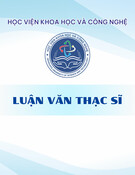

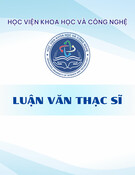
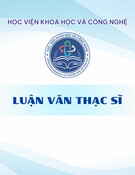
![Luận văn Thạc sĩ: Tổng hợp và đánh giá hoạt tính chống ung thư của hợp phần lai tetrahydro-beta-carboline và imidazo[1,5-a]pyridine](https://cdn.tailieu.vn/images/document/thumbnail/2025/20250816/vijiraiya/135x160/26811755333398.jpg)

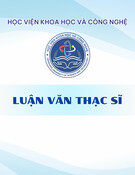






![Đề án Thạc sĩ: Tổ chức hoạt động văn hóa cho sinh viên Trường Cao đẳng Du lịch Hà Nội [Chuẩn nhất]](https://cdn.tailieu.vn/images/document/thumbnail/2025/20251202/kimphuong1001/135x160/91661764646353.jpg)
